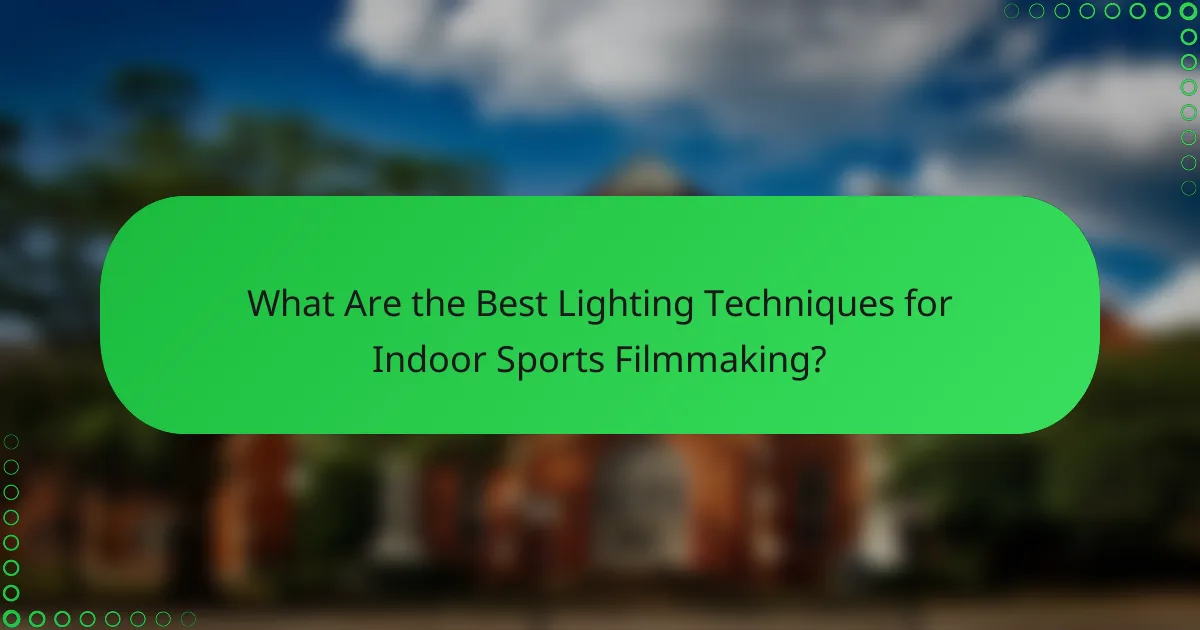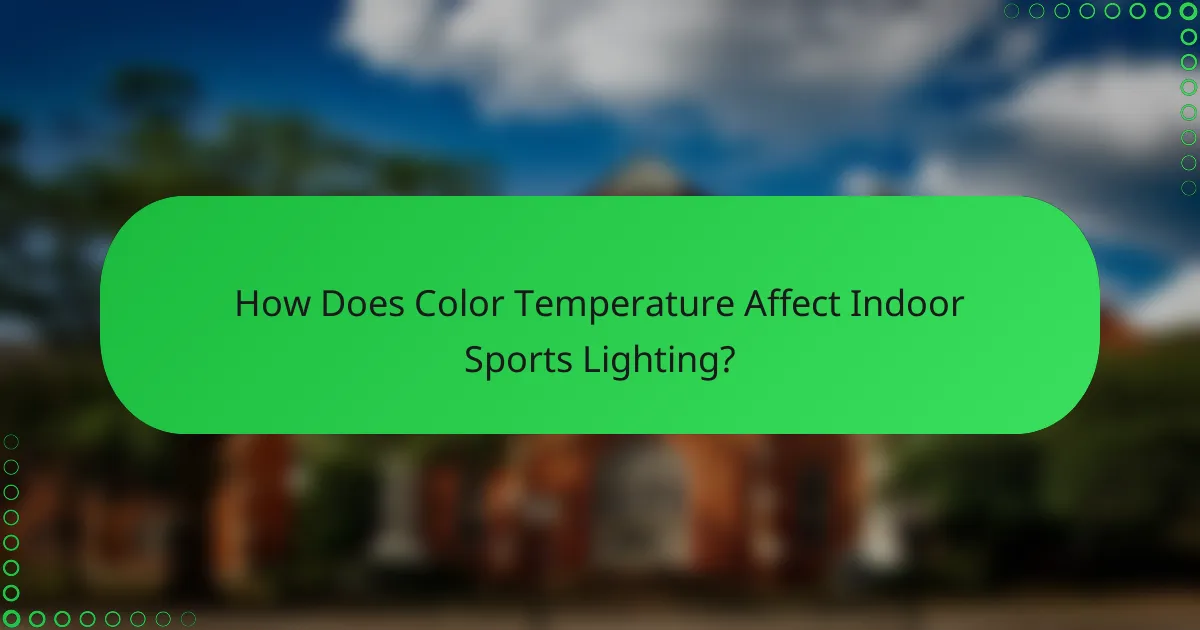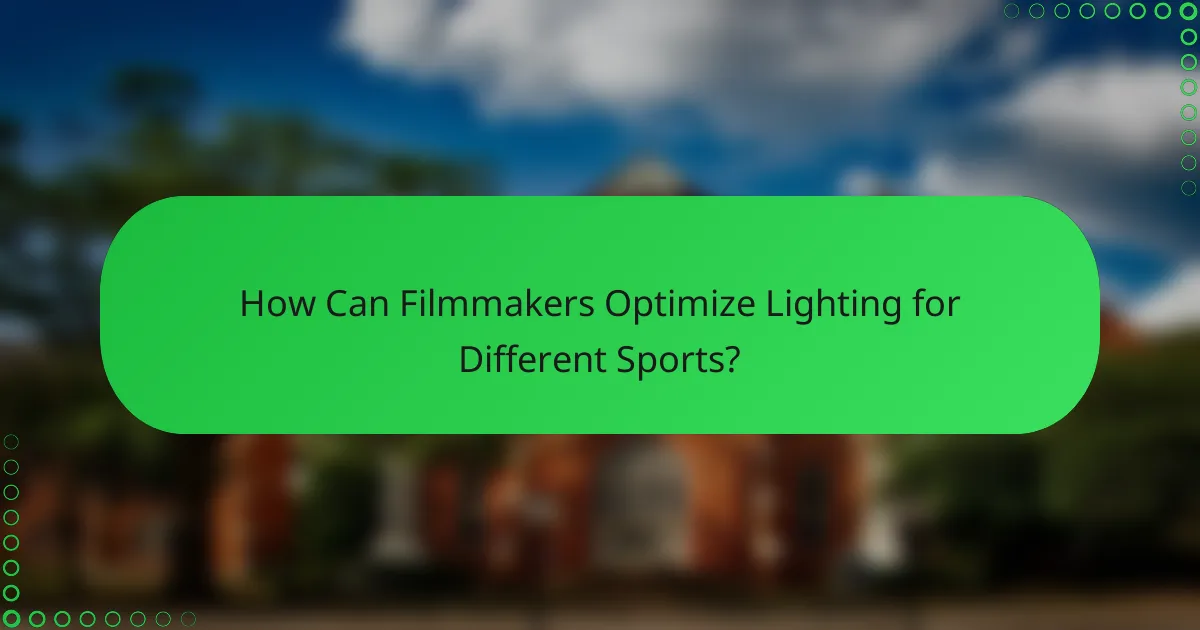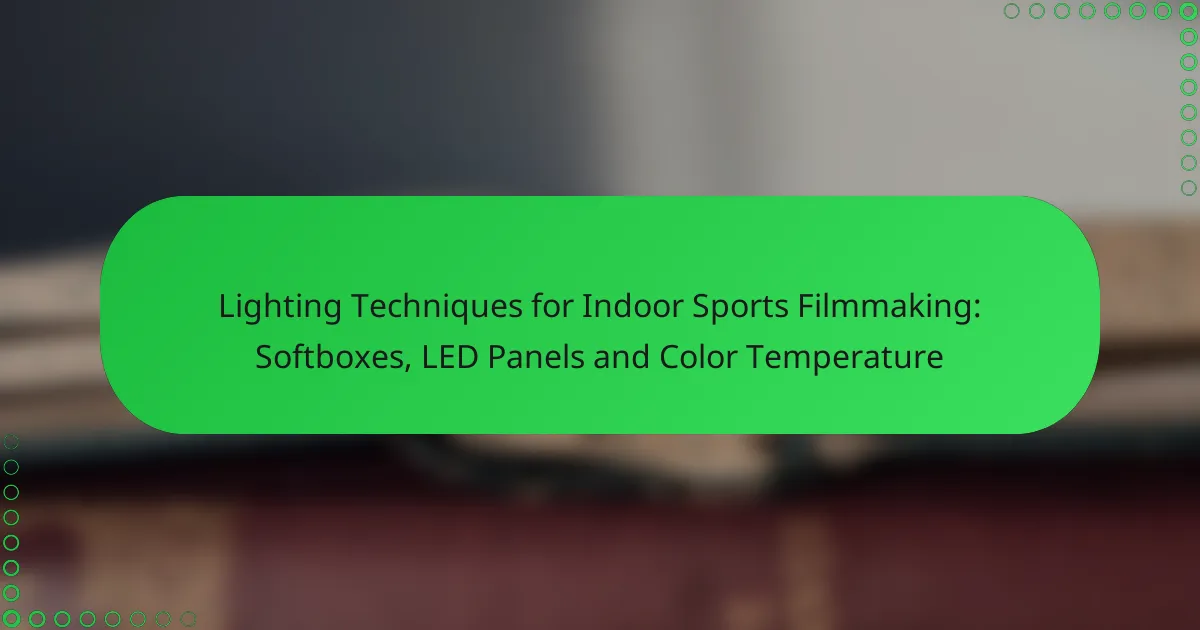Effective lighting techniques are essential for indoor sports filmmaking, with softboxes, LED panels, and precise color temperature adjustments playing key roles. Softboxes provide soft, diffused light that reduces harsh shadows, while LED panels offer versatility and energy efficiency, making them ideal for dynamic environments. Together, these tools help filmmakers capture high-quality footage that showcases both the action and atmosphere of the sport.

What Are the Best Lighting Techniques for Indoor Sports Filmmaking?
The best lighting techniques for indoor sports filmmaking include using softboxes for even illumination, LED panels for versatility, and adjusting color temperature to set the right mood. These techniques help capture high-quality footage that highlights the action and atmosphere of the sport.
Softbox lighting for even illumination
Softbox lighting is ideal for indoor sports as it provides a broad, diffused light that reduces harsh shadows. This even illumination is crucial for capturing fast-paced action without distracting contrasts or glares.
When using softboxes, position them at a 45-degree angle to the subject to achieve optimal lighting. Consider using two softboxes to create a balanced light setup, ensuring that all areas of the playing field are well-lit.
LED panels for versatility
LED panels are a popular choice for indoor sports filmmaking due to their flexibility and portability. They can be easily adjusted for brightness and color temperature, allowing filmmakers to adapt to various environments and lighting conditions.
These panels are lightweight and can be mounted on stands or hung from ceilings, making them suitable for tight spaces. Look for panels with adjustable color settings to match the ambient light in the venue, enhancing the overall quality of the footage.
Color temperature adjustments for mood
Adjusting color temperature is essential for setting the mood in indoor sports filmmaking. Warmer tones can create a more intimate atmosphere, while cooler tones can convey a sense of energy and excitement.
Use color temperature settings between 3200K and 5600K to match the existing light sources in the venue. This adjustment helps maintain color accuracy and ensures that skin tones and uniforms appear natural in the final footage.
Using diffusers for soft light
Diffusers can be used in conjunction with softboxes or LED panels to further soften the light. By placing a diffuser in front of the light source, you can reduce harshness and create a more flattering illumination for athletes.
Common materials for diffusers include silk or frosted plastic. Experiment with different types to see which produces the best results for your specific filming environment.
Combining multiple light sources
Combining multiple light sources can enhance the overall lighting setup for indoor sports filmmaking. Using a mix of softboxes, LED panels, and other lights allows for greater control over shadows and highlights.
When combining lights, ensure they have similar color temperatures to avoid mismatched lighting. This consistency helps create a cohesive look in your footage, making the action more visually appealing.

How Do Softboxes Enhance Indoor Sports Filmmaking?
Softboxes enhance indoor sports filmmaking by providing soft, diffused lighting that minimizes harsh shadows and evenly illuminates the scene. This results in a more professional and visually appealing look, crucial for capturing dynamic sports action.
Softboxes reduce harsh shadows
Softboxes are designed to soften the light emitted from a source, which significantly reduces harsh shadows on athletes and the playing surface. This is particularly important in indoor sports where lighting can often create unflattering contrasts and distracting shadows.
By diffusing the light, softboxes help maintain a consistent appearance across the entire scene, allowing viewers to focus on the action without being distracted by uneven lighting. This is especially beneficial for close-up shots where detail is critical.
Softboxes provide even light distribution
One of the key advantages of using softboxes is their ability to provide even light distribution across the entire area being filmed. This is essential in indoor sports, where uneven lighting can lead to areas of overexposure or underexposure.
When placed strategically, softboxes can illuminate the entire playing field or court, ensuring that all athletes are well-lit regardless of their position. This uniformity helps in maintaining the visual integrity of the footage, making it easier to edit and produce a cohesive final product.
Softboxes are portable and easy to set up
Softboxes are typically lightweight and designed for quick assembly, making them an ideal choice for filmmakers on the go. Their portability allows for easy transport to various indoor venues, which is crucial for sports events that may take place in different locations.
Most softboxes can be set up in just a few minutes, allowing filmmakers to focus on capturing the action rather than spending excessive time on lighting arrangements. This efficiency is particularly valuable during fast-paced sports events where timing is critical.

What Are the Advantages of LED Panels in Sports Filmmaking?
LED panels offer numerous advantages in sports filmmaking, including energy efficiency, adjustable settings, and compact designs that fit well in various indoor environments. Their versatility makes them a popular choice for capturing high-quality footage in dynamic settings.
Energy efficiency and low heat output
LED panels are known for their energy efficiency, consuming significantly less power compared to traditional lighting options. This efficiency translates into lower electricity costs, making them a cost-effective choice for long filming sessions.
Additionally, LED lights produce minimal heat, which is crucial in indoor sports settings where athletes are already exerting themselves. The reduced heat output helps maintain a comfortable environment for both the crew and the participants.
Adjustable brightness and color temperature
One of the standout features of LED panels is their ability to adjust brightness and color temperature easily. Filmmakers can modify these settings to match the ambient light conditions or achieve specific visual effects, enhancing the overall quality of the footage.
Typically, LED panels allow for a wide range of color temperatures, from warm tones around 2700K to cooler tones up to 6500K. This flexibility helps in creating the desired mood and atmosphere, essential for sports storytelling.
Compact design for tight spaces
The compact design of LED panels makes them ideal for tight filming spaces often found in indoor sports venues. Their slim profile allows for easy placement in various locations without obstructing the action or crowd views.
Moreover, many LED panels are lightweight and portable, facilitating quick setup and adjustments during fast-paced events. This portability is particularly beneficial for filmmakers who need to adapt to changing environments swiftly.

How Does Color Temperature Affect Indoor Sports Lighting?
Color temperature significantly influences the mood and visual clarity of indoor sports lighting. Measured in Kelvin (K), it affects how colors appear on camera, impacting the overall aesthetic and viewer experience.
Warm tones for a cozy atmosphere
Warm tones, typically ranging from 2700K to 3500K, create a welcoming and comfortable environment. These tones can soften the harshness of indoor lighting, making them suitable for sports that emphasize community and engagement, like basketball or volleyball.
Using warm lighting can enhance skin tones and create a more inviting atmosphere. However, be cautious; too much warmth can dull the vibrancy of the players’ uniforms and the overall action.
Cool tones for a dynamic feel
Cool tones, generally between 5000K and 6500K, evoke energy and excitement, making them ideal for fast-paced sports like hockey or soccer. This color temperature mimics daylight, which can enhance clarity and detail in high-motion scenes.
While cool lighting can make action stand out, it may also create a sterile feel if overused. Balance is key; consider mixing cool tones with softer lighting to maintain a dynamic yet inviting atmosphere.
Matching color temperature to venue lighting
It’s crucial to match your lighting setup with the existing venue lighting to ensure consistency. If the venue uses warm fluorescent lights, introducing cool LED panels can create jarring contrasts that distract viewers.
To achieve a cohesive look, assess the venue’s lighting and adjust your equipment accordingly. A color meter can help determine the venue’s color temperature, allowing you to select the right softboxes or LED panels for a seamless blend.

What Are the Key Considerations for Choosing Lighting Equipment?
When selecting lighting equipment for indoor sports filmmaking, consider factors such as budget, space, portability, and compatibility with your camera settings. These elements will significantly influence the quality of your footage and the efficiency of your setup.
Budget constraints for filmmakers
Budget is a crucial factor when choosing lighting equipment. High-quality softboxes and LED panels can range from a few hundred to several thousand dollars. Determine your budget early on to narrow down your options and avoid overspending.
Consider the long-term investment of your lighting equipment. While cheaper options may save money upfront, they might lack durability or performance, leading to additional costs in the future. Aim for a balance between quality and affordability.
Space and portability requirements
Evaluate the space where you will be filming. Larger softboxes may require more room to set up and may not be suitable for smaller indoor venues. Conversely, compact LED panels can fit into tight spaces and are often easier to transport.
Portability is essential if you plan to shoot in various locations. Lightweight and collapsible lighting setups can save time and effort during transitions. Look for equipment that is easy to assemble and disassemble for maximum convenience.
Compatibility with camera settings
Ensure that your lighting equipment is compatible with your camera settings, particularly regarding color temperature. Most indoor sports environments benefit from lights that can adjust between 3200K to 5600K to match various lighting conditions.
Check if your camera can handle the intensity and type of lighting you choose. Some cameras perform better with softer light, while others may require more powerful sources. Test your setup before filming to avoid issues during production.

How Can Filmmakers Optimize Lighting for Different Sports?
Filmmakers can optimize lighting for various sports by understanding the specific lighting needs of each activity and utilizing appropriate equipment. Key considerations include the type of sport, the venue’s lighting conditions, and the desired visual effects.
Softboxes
Softboxes are essential for creating diffused, even lighting, which is particularly beneficial for indoor sports. They help reduce harsh shadows and provide a soft glow that enhances the athletes’ features without causing glare. When using softboxes, consider their size and placement to ensure adequate coverage of the playing area.
For sports like basketball or volleyball, positioning softboxes at a 45-degree angle above the action can produce flattering light. A common setup involves using two or three softboxes to cover different angles, ensuring consistent illumination throughout the game.
LED Panels
LED panels are versatile lighting tools that offer adjustable brightness and color temperature, making them suitable for various indoor sports settings. They are energy-efficient and can be easily mounted or moved, allowing filmmakers to adapt to changing conditions quickly.
When selecting LED panels, look for options that allow for color temperature adjustments, typically ranging from 3200K to 5600K. This flexibility helps match the ambient light in the venue, ensuring a cohesive look in the final footage.
Color Temperature
Color temperature plays a crucial role in sports filmmaking, affecting the mood and clarity of the footage. For indoor environments, maintaining a consistent color temperature is vital to avoid unnatural color casts. Typically, a color temperature of around 5600K is ideal for simulating daylight.
To achieve the best results, use color temperature meters to measure the existing light and adjust your lighting setup accordingly. Mixing different light sources can lead to color imbalances, so aim for uniformity by using similar types of lights throughout the shoot.
